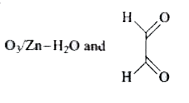Identify the reactants (X) and (Y) for the following reaction, respectively.
(X)+(Y)NaNH2−−−−→4− Decyne
CH3(CH2)4CH2−Cl+CH3−C≡CH
CH3(CH2)2CH2−Cl+CH3−(CH2)2−C≡CH
CH3(CH2)2CH2−Cl+CH3(CH2)−C≡CH
CH3−CH2−CH2−Cl+CH3(CH2)4−C≡CH
The correct Answer is:D
To identify the reactants (X) and (Y) for the reaction that produces 4-decyne in the presence of sodium amide (NaNH2), we can follow these steps:
Step 1: Understand the Reaction
The reaction involves the formation of 4-decyne, which is a terminal alkyne with the formula \( \text{C}_{10}\text{H}_{18} \). The general reaction involves an alkyne and an alkyl halide reacting in the presence of a strong base.
Step 2: Identify the Structure of 4-decyne
4-decyne has the structure:
CH3−CH2−CH2−C≡C−CH2−CH2−CH2−CH2−CH3
This indicates that it has a total of 10 carbon atoms, with the triple bond located between the 4th and 5th carbon atoms.
Step 3: Determine Reactants \( (X) \) and \( (Y) \)
1. Alkyne \( (X) \): To form 4-decyne, we need a suitable alkyne that can provide the necessary carbon chain. A suitable choice is 1-butyne \( (CH_3CH_2C≡CH) \) because it has 4 carbons and can be extended to 10 carbons through nucleophilic substitution.
2. Alkyl Halide \( (Y) \): The alkyl halide must provide the remaining 6 carbons. A suitable alkyl halide is 1-bromohexane \( (CH_3(CH_2)_5Br) \) which has 6 carbons.
Step 4: Reaction Mechanism
- The strong base \( \text{NaNH}_2 \) will abstract the acidic hydrogen from 1-butyne, forming a nucleophile \( (C_4H_9^-) \).
- This nucleophile will then attack the alkyl halide (1-bromohexane), leading to the formation of 4-decyne.
Conclusion
Thus, the reactants \( (X) \) and \( (Y) \) are:
- \( (X) \): 1-butyne \( (CH_3CH_2C≡CH) \)
- \( (Y) \): 1-bromohexane \( (CH_3(CH_2)_5Br) \)
The reaction involves the formation of 4-decyne, which is a terminal alkyne with the formula \( \text{C}_{10}\text{H}_{18} \). The general reaction involves an alkyne and an alkyl halide reacting in the presence of a strong base.
4-decyne has the structure:
CH3−CH2−CH2−C≡C−CH2−CH2−CH2−CH2−CH3
This indicates that it has a total of 10 carbon atoms, with the triple bond located between the 4th and 5th carbon atoms.
1. Alkyne \( (X) \): To form 4-decyne, we need a suitable alkyne that can provide the necessary carbon chain. A suitable choice is 1-butyne \( (CH_3CH_2C≡CH) \) because it has 4 carbons and can be extended to 10 carbons through nucleophilic substitution.
2. Alkyl Halide \( (Y) \): The alkyl halide must provide the remaining 6 carbons. A suitable alkyl halide is 1-bromohexane \( (CH_3(CH_2)_5Br) \) which has 6 carbons.
- The strong base \( \text{NaNH}_2 \) will abstract the acidic hydrogen from 1-butyne, forming a nucleophile \( (C_4H_9^-) \).
- This nucleophile will then attack the alkyl halide (1-bromohexane), leading to the formation of 4-decyne.
Thus, the reactants \( (X) \) and \( (Y) \) are:
- \( (X) \): 1-butyne \( (CH_3CH_2C≡CH) \)
- \( (Y) \): 1-bromohexane \( (CH_3(CH_2)_5Br) \)
Similar Questions
Knowledge Check
What are reactant X and product Y in the following sequence of reactions?
 A
A B
B C
C D
D

Identify X and Y of the above reactionA B
B C
C D
D

Identify the product of the following elimination reaction X and Y respectively with stereochemistry :
View SolutionIdentify the reagents A and B respectively in the following reactions
CH3COOHA−−→CH3COClB−−→CH3CHO
View SolutionIdentify X and Y in the reaction:

View SolutionIdentify X and Y in the following reactions .
PbSHeat−−−−−→in air(X)
(X)+PbSY−−→Pb+SO2.
View SolutionIdentify X and Y in the following reaction BCl3+NH4Cl140∘C/C6H5Cl−−−−−−−−−→XNaBH4−−−−→Y
View SolutionThe final product (Y) of the following reaction is:
C2H4Br2−−→ X Ph3SnH−−−−→ Y
View Solution


 ,
,